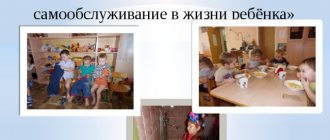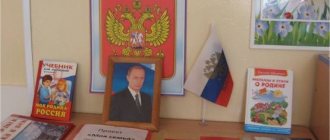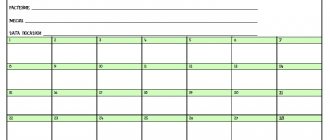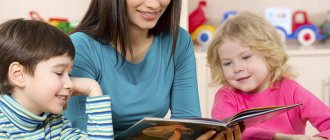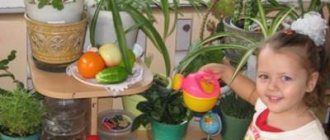In 2020, the government adopted several new standards for the admission of children to preschool educational organizations. What is the essence of the changes, how to organize work in a kindergarten correctly and in a new way, what steps should the manager take, what educators should know - we will briefly consider in the article.
The changes apply at the federal level, so they are valid in each region.
- Benefits for brothers and sisters
- Rules for transfer between kindergartens
- Accounting for the number of foreigners
- Mandatory electronic queue and unified federal system
- Additional information to the rules
Benefits for brothers and sisters
Federal Law No. 411-FZ dated December 2, 2019 obliges us to admit, as a priority, children who have a brother or sister studying in the same kindergarten. This innovation applies not only to kindergartens, but also to schools.
The benefit can be used by parents who have submitted to the regional education department a certificate of registration of the second child at the address where the first one is registered. If the place of residence differs from the place of registration or the children have different places of registration, you must additionally provide a certificate of family composition. It is received at the passport office.
Previously, parents had to take their children to different kindergartens if their place of registration did not match. The new rule has been well received by families because it will free up time for parents. This bill was introduced in the Samara region in 2022. The prosecutor's office closed him down because he infringed on the rights of residents of other regions. And the new law of 2022 was adopted at the federal level, so the conditions are the same for all regions.
How are priorities distributed in the queue?
Children whose brothers and sisters are already studying in kindergarten receive priority over children from the general queue and even over other beneficiaries. The queue order is determined as follows:
- Brothers and sisters of current kindergarten students;
- Children of military personnel, police officers and the Ministry of Internal Affairs, disabled people, large families, single mothers. In some regions, children of kindergarten employees are included in this category, for example in St. Petersburg.
- Babies from the queue according to the date of application;
- Children who are transferred from other kindergartens;
- Children registered at their place of residence.
How to organize innovation in kindergarten
The essence of the new benefit must be conveyed to parents and described in the documents of the preschool educational institution. To do this, post information about the new preferential category on the kindergarten website and on information boards.
Also, change the section of the regulations on admission to preschool educational institutions in 2022. To do this, supplement the section “Procedure for admission of pupils” with information about the preferential category and the sequence of enrollment of children among preferential and non-preferential categories.
Correct daily routine for a 3 year old child
hope lutai
Correct daily routine for a 3 year old child
CONTENT:
Peculiarities of age Main routine moments What to fill the day with? Standard daily routine
At the age of three, the child becomes more active. He needs a lot of energy for games and cognitive activities, communication with peers. To do this, it is important to provide him, first of all, with adequate day and night rest and proper nutrition . What should be the daily routine for a 3 year old child ?
FEATURES OF AGE
At 3 years old, the child enters a new stage of development. He becomes a member of society, so communication with his parents is no longer enough for him. Communication with peers is of great importance. If a child does not yet attend kindergarten, he needs to be provided with communication with other children on the playground. You can enroll him in an early development group so that he gradually gets accustomed to children's society. If the baby went to preschool, he will have to be put to bed and woken up early in the morning. Find out the daily routine of the kindergarten your baby will attend, and gradually teach your child to sleep , eat, and stay awake at the right time. This transition can take up to six months, so you need to take care of it in advance. Now the baby is already able to stay awake for about 5–6 hours, his need for rest is slightly reduced. So, daytime sleep is now left alone and can last about 1.5–2 hours. But it must be present - while the child still cannot do without daytime rest. This situation will continue until 6–7 years. The baby's physical activity increases significantly. He already overcomes obstacles with ease, can ride a bicycle, swing, run and jump for a long time, climb onto heights, and jump off. old child’s routine should include enough time for active games and physical activity.
MAIN MOMENTS
The daily need for rest for three-year-olds is about 11 hours: 9 are for night sleep, approximately 2 hours for daytime sleep. It is best to put your child to bed after lunch , when he is tired enough after a morning walk. It is advisable to organize a night's sleep no later than ten in the evening. It is important that he sleeps 9 hours before 7 am in order to be on time for kindergarten if he goes there (or to get used to this routine)
.
-year-old child eat at least 4 times. This includes breakfast, lunch, afternoon tea and dinner. Products must provide the child with the necessary supply of energy and nutrients so that he can be physically and mentally active during the day, and therefore develop properly . If the weather permits, you need to walk outside for at least 4 hours a day: before lunch and before dinner. At the same time, during the warm season, all free time should be spent outdoors. This will have a beneficial effect on the baby’s appetite, sleep and overall development.
IT IS IMPORTANT!
Try to get your baby out of the habit of snacking between meals. Otherwise, he simply will not be hungry at the right time. It is especially harmful to snack on flour or sweets. Explain to your relatives that you don’t need to feed your child cookies or chocolates to win his favor. There are more useful things for this. For example, fun games, songs or dances.
WHAT TO FILL YOUR DAY?
Let's start with the fact that the day of a three-year-old child should not go “point by point”
from waking up to going to bed.
There is always free time between meals and bedtime. Therefore, it is important to know what and when you can do with your child . After waking up, you need to teach your baby to participate as much as possible in making the crib and folding his pajamas. This will help the child get used to being independent at home. After sleep and before going to bed at night, water procedures are important. In the morning, the child must wash his face and brush his teeth. In the evening, in addition, take a swim. To practice your toothbrush skills, you can hang a visual aid near the sink. To make bathing more fun, take special toys with you to the bathroom. (By the way, these can be ordinary bowls-mugs with which the child will pour water, empty shampoo bottles for “water shooting”
).
Hands must be washed before each meal. Physical activity begins with morning exercises (read more about this here)
.
Charging should last at least 15 minutes and include exercises for the arms, legs, head, and torso. This will help awaken the entire body. To make studying more interesting, you can turn on funny music (for example, from your favorite cartoon)
.
In summer, it is better to do exercises in the fresh air - in the yard or on the balcony. Children at this age learn from the example of their parents, so mom or dad will certainly do the child
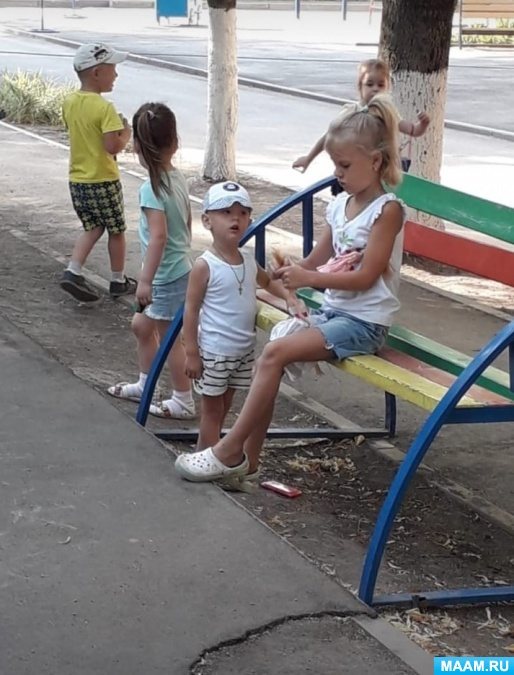
During walks, the child should move as much as possible: jump on ladders, logs, slides, jump on trampolines, ride a swing, bike or scooter, run and frolic in the company of other children. Free time between walks, meals and sleep should not be “empty”
.
The child can play independently (draw, do construction, sculpting, or together with his parents, including educational games. It will not be superfluous to involve the baby in household chores. Let him help his mother wipe the dust, clear the table, put the laundry in the laundry , disassemble after drying. During such work the child will unobtrusively get acquainted with many household appliances, the mother will tell him how they work, what they are needed for. And this is the development of cognitive activity, broadening his horizons and simply getting involved in helping parents with household work. It is important to remember that 2-3 hours before bedtime, activities should become calmer: running and jumping is not advisable now, the baby needs time to calm down and prepare for bed. You can draw, read books, look at and describe pictures, play with mosaics.
THIS IS IMPORTANT!
Buy a calendar that shows the year, month, date, day of the week, and also has the ability to move the numbers. Every morning, talk to your baby about what day it is today. The baby will learn to navigate in time, and awakening will be smoother.
STANDARD DAY ROUTINE
In fact, there is no universal routine for three-year-olds. As for children of other ages, since each family has its own way of life, mom and dad have their own work schedule, they have their own interests, other brothers and sisters in the family also have their own needs. Therefore, routine of one family member should not disrupt the routine of others. When compiling it, you can focus on a certain established standard, which needs to be adjusted to specific circumstances. It looks like this:
- 7:00–7:15 – getting up, water procedures;- 7:15–8:30 – morning exercises;- 7:30–8:00 – time for the baby to study independently or help mom set the table;- 8:00 –8:30 – breakfast;- 8:30–9:30 – educational games with mom;- 9:30–11:30 – morning walk;- 11:30–12:00 – preparation for lunch (changing clothes, washing hands , cleaning up toys that were taken with you, helping mom); - 12:00–12:30 – lunch; - 12:30–14:30 – afternoon nap; - 14:30–16:00 – awakening, child’s independent play within sight of mom ;- 16:00–16:30 – afternoon snack;- 16:30–18:00 – second walk in the park or on the playground;- 18:30–19:00 – dinner;- 19:00– 20:00 – quiet games; - 20:00–20:30 – cleaning toys, cleaning the room; - 20:30–21:30 – bathing, massage, evening bedtime ritual, sleep until morning.
The daily routine is the basis that helps to distribute the necessary activities and actions over the hours, organize them and master this order. And this means order in life, stability, which is so important for the child’s psyche.
Rules for transfer between kindergartens
The rules for transferring children to another kindergarten have been brought into line with the rules for admission:
- Parents submit an application to the regional education department, which means they do not need to apply to the kindergarten. Only if the child is transferred to a private kindergarten, the application is written directly to it, bypassing the education department.
- If the regional authority replies that there is a free place in the new kindergarten, parents receive a referral to this kindergarten.
- Only after this do parents write an application for expulsion from the previous preschool institution.
These procedures can be completed via the Internet in the regional information system.
Daily routine in kindergarten
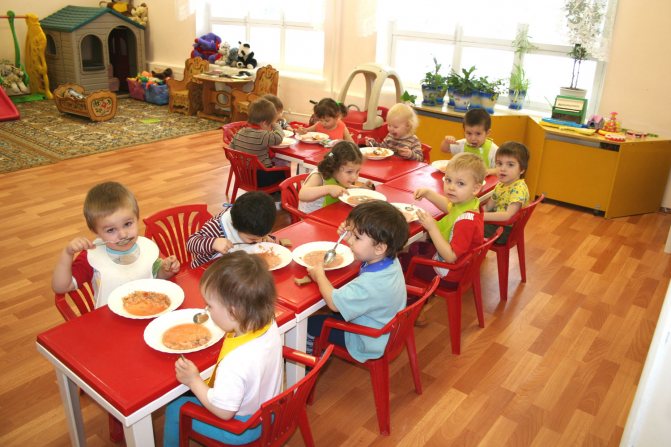
Therefore, if at home you are used to sleeping until lunch, not putting your child to bed and eating whenever you want, then before entering a preschool institution you need to bring your home daily routine as close as possible to the routine in kindergarten. This will help the child during the adaptation period. Typically, three-year-olds easily adapt to kindergarten. At this age, they are ready to communicate with their peers and other adults and gain new knowledge. Being raised at home, the child does not receive the necessary social communication. In addition, in kindergarten, classes with the child are conducted according to a special program that corresponds to his age characteristics.
In a group of peers, it is much easier for a child to learn to communicate or gain self-service skills by looking at other children. And in order for your child to endure the adaptation period even easier, you need to accustom him to the regime within 2-3 months. It is very difficult to maintain a rigid daily routine at home. And in kindergarten it is built optimally for a little person and contributes to his physiological and psychological development.
The regime in different kindergartens may differ, but its principle is the same everywhere.
Approximate daily routine in kindergarten

Meals and sleep remain constant in the daily routine. The walk depends on weather conditions and time of year. If the weather is bad, games or activities are held at this time. Some kindergartens also have a second breakfast.
Do you want to know the microclimate of your family? Take the TEST ON OUR WEBSITE and find out if anything needs to be changed
Also read on our website: Should a child be banned?
Requirements for the daily routine in kindergarten according to SanPiN
Children are provided with four meals a day at the group premises. The interval between meals is no more than 4 hours. For more information about diet, diet and menu, see here.
A walk is organized 2 times a day: in the first half of the day and after sleep, which is a total of 3 - 4 hours. At temperatures below -15°C and wind speeds of more than 7 m/s, the duration of the walk is reduced.
Daytime sleep for children from 3 to 7 years old is 2 - 2.5 hours. During nap time, the presence of a teacher in the bedroom is mandatory. Before going to bed, it is not recommended to conduct active and emotional games and activities.
Independent activity of children 3–7 years old should take at least 3–4 hours a day. This includes independent play, preparation for educational activities, and personal hygiene.
All rooms must be ventilated daily. Through ventilation is carried out at least 10 minutes every 1.5 hours in the absence of children, 30 minutes before they arrive from a walk or activity. In the presence of children, ventilation is permissible only in the warm season without a draft. When ventilating, the air temperature should not drop by more than 2-4°C.
Bed linen is changed at least once a week.
Have you already chosen what to give your baby for New Year? How to please and surprise your beloved baby? The New Year family holiday is an opportunity to give your child bright emotions from shared entertainment. Let your baby remember this magic and fairy tale for the rest of his life! The best New Year's greetings for a baby - personal interactive greetings!
One of the reviews from a caring grandfather: “My granddaughter was still very young when I bought her the very first disc. To say that it is magical is to say nothing! The cub sat with his mouth open and believed that it was really Santa Claus talking to her. I bought it every year and never regretted it. Now, of course, she’s grown up and it’s difficult to surprise her with Santa Claus... Thank you for being able to give your baby a fairy tale for the New Year!”
Download the series as a New Year's gift and you will see how much happiness your child will receive from watching the fairy-tale game plot! Look at all the unusual options for New Year's greetings for your baby HERE!
Organization of classes

It is mandatory for the harmonious development of the child to include developmental activities in the daily routine according to SanPiN, which subsequently serve as preparation for school.
Also read on our website: How to calm down and stop being nervous when your child doesn’t listen
Classes in kindergarten are conducted in the main areas:
- musical;
- physical training;
- art;
- classes to develop fine motor skills;
- speech development classes;
- introduction to basic mathematical knowledge.
Activities that require increased cognitive activity and mental stress of children are held in the first half of the day and alternate with physical education and music classes to avoid overworking the child.
The continuous duration of an educational lesson for a preschooler does not exceed:
- 10 minutes for children 3 - 4 years old (younger group);
- 15 minutes for children 4 - 5 years old (middle group);
- 20 minutes for children 5 - 6 years old (older group);
- 30 minutes for children 6 - 7 years old (preparatory group).
No more than 3 classes are held per day. Breaks between classes are at least 10 minutes.
Physical development classes

Physical development classes are held at least 3 times a week. Their duration ranges from 15 to 30 minutes depending on the age group. In summer, such activities are recommended to be carried out outdoors.
In addition to physical development classes, other forms of physical activity are also used: morning exercises, physical exercises, outdoor games, and in some kindergartens - exercise classes, swimming, etc.
Morning reception for children
Reception of children should be carried out by educators and (or) medical workers. Identified sick children or children with suspected illness are not accepted. If a child falls ill during the day, he is isolated from healthy children (placed in a medical room) until the parents arrive or are hospitalized, with the parents informed.
Accounting for the number of foreigners
Federal Law No. 403-FZ dated December 2, 2019 obliges kindergartens to publicly publish the number of foreign preschoolers. There is no need to disclose other data of migrants in order not to violate legal norms.
Preschool education experts say what this innovation could lead to:
- On the one hand, the attitude towards Russian citizens who are mistakenly mistaken for foreigners will improve. This applies, for example, to residents of the North Caucasus.
- On the other hand, parents can begin to divide groups and kindergartens into “for locals” and “for migrants,” and children can unite into small groups based on linguistic similarity. As a result, queues at individual kindergartens may increase and tension among parents may increase.
To avoid the described difficulties, a rule on the number of foreigners was added to the rules for admitting kindergartens in 2020.
How to organize innovation in kindergarten
To implement the new rule, you need to:
- Create an order for the admission of foreign citizens;
- Add to the document on the distribution of responsibilities a task for the senior teacher - to keep track of the number of foreigners in groups.
- Post information on the website about the number of migrants in the kindergarten.
Getting ready for the garden. Daily routine for the nursery group.
Parents face a difficult task - preparing their child for kindergarten. It will be much easier for a child to adapt if, despite the unusual environment for him, the daily routine will be natural for him. As a note to parents, we provide an approximate daily schedule and menu in the nursery group of the kindergarten.
Mode for a nursery group for children (1.5 -2 years)
8:00
morning exercises (running, jumping, games).
8:10-8:40
breakfast, for which the children are offered cottage cheese soufflés and casseroles (1-2 times a week), milk kazhi, steamed omelet or egg porridge with fresh vegetable salad, a warm drink.
9:10-9:20 and 9:20-9:30
classes aimed at the diversified development of the child: music, physical education, dancing, sensory skills with elements of mathematics, drawing, modeling, knowledge of the surrounding world, speech development.
In this case, two activities should not overlap or repeat each other, so as not to tire the child. It is optimal when classes to develop thinking, imagination, and speech are replaced by fast and active games, dancing, and physical exercises. 9:30-11:30
walk.
Outdoor games. 11:30-12:00
lunch.
At this time, children are given pureed vegetarian soups, steamed meat dishes (meatballs, cutlets) or boiled fish, side dishes in the form of cereal dishes or mashed potatoes, salads from fresh vegetables (daily). For the third course every day, children receive fortified drinks (compote, jelly). 12:15-15:00
nap.
15:00-15:30
gradual rise, carrying out hygiene and health measures (light warm-up).
15:30-15:45
afternoon snack, which can consist of a drink (milk, kefir, barley coffee drink and flour product (loaf with butter or jam, waffles, cookies).
15:45-16:45
time of active wakefulness. During this during this period, classes are held for the diversified development of the child, but they in no way repeat the morning ones. For example, if in the morning there was drawing and dancing, then in the evening you can sing songs or do modeling.
16:45-17:15
dinner. For which the children are offered dairy products porridge, pureed vegetable dishes, egg omelet with fresh vegetable salad, etc.
17:15
walk, active games, reading fairy tales and just chatting in a pleasant and friendly company.At the same time, dinner in the kindergarten should not be the last meal in the daily diet baby, and in the evening (
19:00-20:00
) at home the child must be fed a home-made dinner.It is best if the evening meal is vegetable dishes: stew of a mixture of vegetables, stewed cabbage, carrot or beet caviar, vegetable cottage cheese casserole soufflés and puddings or milk porridges. This healthy meal will be perfectly complemented by fermented milk products (kefir, yogurt, fermented baked milk), fresh fruits and juices, the abundance of which, unfortunately, the kindergarten menu cannot boast of.
Practice shows that the set of “favorite” dishes in kindergartens can differ markedly. However, do not be alarmed, because tomato and cucumber salad, mashed potatoes, vegetarian borscht and steamed meat cutlet, which your baby is used to at home, occupy a worthy place on the menu in almost all kindergartens.
Share on social networks:
0
Subscribe to our Telegram channel
and our
Instagram
to keep up to date with the most interesting news!
- Comments
Download SocComments v1.3
Mandatory electronic queue and unified federal system
All data on admission to kindergarten must be entered into the federal information system, namely information about:
- number of seats,
- preferential categories,
- queues.
This means that the queue will become electronic in all regions, and parents will be able to easily monitor the situation in kindergartens. Information from regional services is sent to the federal system. In this way, a single all-Russian queue is formed. Thanks to her, children can easily find a place in a new kindergarten if their family has moved to a new city. It wasn't easy before.
In cities with populations over one million people there is already an electronic queue, so little will change in their work. And kindergartens from small cities and towns will have to introduce a new system in order to meet uniform requirements.
The introduction of a federal waiting list makes the kindergarten admission system more “transparent” for parents. Preschoolers will be accepted under the same conditions. And in a few years, officials will be able to study the statistics on the workload of kindergartens by region, and based on these data, take measures to improve the organization of the preschool education system.
How to organize innovation in kindergarten
Many regions have been maintaining local information portals for several years, so working in a unified system should not cause difficulties. To do this you need:
- Study the regional regulations on the information system;
- Draw up a schedule and instructions for entering and updating data in the information system. Add these instructions to the appointment order;
- Issue an order appointing a specialist to receive and enter data.
The concept and meaning of the daily routine. Its features in different age groups
1. The concept and meaning of the daily routine. Its features in different age groups
The daily routine is of great importance for the health and physical development of children. Constant time for eating, sleeping, walking, playing and studying is what I.P. Pavlov called it an external stereotype - a prerequisite for the proper upbringing of a child.
The daily routine is a clear routine of life during the day, providing for the alternation of wakefulness and sleep, as well as the rational organization of various types of activities. A correct regimen that corresponds to the child’s age-related capabilities improves health, ensures efficiency, successful implementation of various activities, and protects against overwork.
The physiological basis that determines the nature and duration of activity is the level of performance of the cells of the cerebral cortex, therefore it is so important not to exceed the performance limit of the central nervous system, as well as to ensure its full functional recovery after work. The degree of morphofunctional maturity of the organism determines the content of the daily routine and the duration of its main elements, among which the following are distinguished:
- dream;
– staying outdoors (walking);
– educational and training activities;
– gaming activities and activities of one’s own choice (reading, music, drawing and other creative activities, sports);
– self-care, family assistance;
– meals;
- personal hygiene.
Sleep ensures complete functional restoration of all body systems. The physiological need for sleep in children of different ages depends on the characteristics of their nervous system and health status. In the preschool period, both night and daytime sleep are required, regardless of whether the child attends a preschool educational institution, a short-stay group or not. A good night's sleep is important for both preschoolers and schoolchildren.
A child under 5 years old is supposed to sleep 12.5–12 hours a day, at 5–6 years old – 11.5–12 hours (of which approximately 10–11 hours at night and 1.5–2.5 hours during the day). The time allotted for night sleep is from 9–9 hours 30 minutes in the evening to 7–7 hours 30 minutes in the morning. Preschool children sleep once during the day. They are put to bed so that they wake up at 15-15 hours 30 minutes. It is not advisable to organize a daytime nap later - this would inevitably lead to a later bedtime at night. A six-hour wakefulness in the afternoon is exactly the period of time during which the child will play enough to feel the need for rest.
Staying in the open air (walking) is the most effective type of recreation, due to increased blood oxygenation, replenishment of ultraviolet deficiency, allowing for the hardening of the body and an increase in physical activity. Walks are especially important for preschool children: in winter, at least 4–4.5 hours, and in summer, if possible, all day. The walk is not carried out at an air temperature below -15 °C and a wind speed of more than 15 m/s for children under 4 years old, and for children 5–7 years old at an air temperature below -20 °C with a wind speed of more than 15 m/s (for average stripes).
Educational and educational activities.
When constructing a rational training regimen, one should take into account the biorhythms of the functioning of the child’s body. In most healthy children, the greatest excitability of the cerebral cortex and performance are determined in the morning period - from 8:00 to 12:00 hours and in the evening - from 16:00 to 18:00 hours.
Training and education programs at preschool educational institutions provide for developmental activities. In the younger group, the duration of classes is 10–15 minutes (10 lessons per week), in the middle group (4–5 years old) - 20 minutes (10 lessons per week), in the older group (5–6 years old) - two lessons per week. day for 20–25 minutes with a break of 10 minutes. In the preparatory group (6–7 years old) – 3 lessons a day are held for 25–30 minutes, taking on the nature of training. Hygienic studies have shown that classes on speech development, literacy, mathematics, and familiarization with the outside world are more tiring than modeling, drawing, and design. Physical education and music (dynamic exercises) reduce or relieve fatigue.
One of the means of physical education is the correct implementation of a regime compiled for each age group of children, taking into account their psychophysiological characteristics. If the regime is carried out correctly, then children are calm, actively engaged, play, eat well, fall asleep quickly and sleep soundly, and wake up cheerful and cheerful.
The daily routine for each age group indicates the approximate time that elapses from the inclusion of the first child in this routine process until the last child ends it.
The younger the children are, the less independent they are, the more important it is to maintain the principle of gradualness when carrying out all routine moments.
It is important to make seasonal changes to your daily routine. The program offers modes for both cold and warm seasons.
In winter, due to the weather conditions and the large number of activities with children, the child’s time outdoors during the day is somewhat reduced.
Therefore, a walk is of particular importance, which is extremely important to carry out systematically at least 2 times a day. In summer and other warm periods of the year, the daily duration of children’s stay in the fresh air increases, since the number of classes is reduced to one and almost all routine processes are carried out on the site, if possible. Most of the activities with children are physical education, music, familiarization with the environment, etc. – should also be carried out in the fresh air.
In order for a walk to be not only useful, but also interesting, its content should be properly planned: conduct outdoor games, sports entertainment, introduce children to their surroundings, to nature, to the work of adults on the site, on the street, to involve children in work that is feasible for them. in the garden, going on excursions outside the site, etc.
When implementing the regime, it is necessary to ensure a timely change in the types of activities of children.
When planning work, the teacher provides that classes in which children move little (on the development of elementary mathematical concepts, drawing, etc.) are replaced by physical education and music classes. If children show signs of fatigue (excitement, inattention, motor restlessness, etc.), a physical education minute is held.
During the periods of time allocated for independent activity of children, much attention is paid to ensuring their physical activity.
Based on the best experience of preschool institutions and the achievements of pedagogical science, an approximate daily routine has been developed for each age group of a preschool educational institution, which is included in the “Education Program in Kindergarten”. The standard regime is designed for a 12-hour stay of children in a preschool institution.
Daily routine (in warm weather)
| Regime processes | 1 junior gr. | 2 jr. gr. | average gr. | senior gr. | prepared gr. |
| Getting up, morning toilet | 6.30–7.30 | 6.30–7.30 | 6.30–7.30 | 6.30–7.30 | 6.30–7.30 |
| Reception, examination, games, morning. gymnastics | 7.00–8.00 | 7.00–8.20 | 7.00–8.25 | 7.00–8.35 | 7.00–8.35 |
| Preparation for breakfast, breakfast | 8.00–8.30 | 8.20–8.55 | 8.25–8.55 | 8.35–9.00 | 8.35–8.55 |
| Games, preparation for a walk, going out | 8.30–8.50 | 8.55–9.15 | 8.55–9.20 | 9.00–9.15 | 8.55–9.05 |
| Lesson (on site) | 8.50–9.00 | 9.15–9.30 | 9.20–9.40 | 9.15–9.45 | 9.05–9.35 |
| Games, observations, air and sun treatments | 9.15–11.30 | 9.30–11.15 | 9.40–11.35 | 9.45–12.15 | 9.35–12.10 |
| Returning from a walk, water procedures, games | 11.30–11.50 | 11.15–11.40 | 11.35–12.00 | 12.15–12.30 | 12.10–12.30 |
| Preparing for lunch, lunch | 11.50–12.30 | 11.40–12.20 | 12.00–12.35 | 12.30–13.00 | 12.30–13.00 |
| Getting ready for bed, sleep | 12.30–15.10 | 12.20–15.10 | 12.35–15.10 | 13.00–15.00 | 13.00–15.00 |
| Wake up, afternoon snack | 15.15–15.35 | 15.10–15.30 | 15.10–15.30 | 15.00–15.25 | 15.00–15.25 |
| Preparing for a walk, games | 15.35–15.50 | 15.30–15.50 | 15.30–16.00 | 15.25–16.10 | 15.25–16.20 |
| Walk, play outside, children go home | 16.40–19.00 | 16.30–19.00 | 16.40–19.00 | 16.50–19.00 | 16.55–19.00 |
Daily routine (in cold weather)
| Regime processes | 1 junior gr. | 2 jr. gr. | average gr. | senior gr. | prepared gr. |
| Getting up, morning toilet | 6.30–7.30 | 6.30–7.30 | 6.30–7.30 | 6.30–7.30 | 6.30–7.30 |
| Reception, examination, games, morning. gymnastics | 7.00–8.00 | 7.00–8.20 | 7.00–8.25 | 7.00–8.30 | 7.00–8.30 |
| Preparation for breakfast, breakfast | 8.00–8.30 | 8.20–8.55 | 8.25–8.55 | 8.30–8.55 | 8.30–8.50 |
| Preparation for classes | 8.20–9.00 | 8.55–9.00 | 8.55–9.00 | 8.55–9.00 | 8.50–9.00 |
| Classes | 8.40–9.15 | 9.00–9.35 | 9.00–9.50 | 9.00–10.50 | 9.00–11.05 |
| Games, preparation for a walk, walk | 9.15–11.30 | 9.35–11.35 | 9.50–11.50 | 10.50–12.25 | 11.05–12.35 |
| Returning from a walk or game | 11.30–12.10 | 11.35–12.00 | 11.50–12.15 | 12.25–12.40 | 12.35–12.45 |
| Preparing for lunch, lunch | 11.50–12.30 | 12.00–12.40 | 12.15–12.50 | 12.40–13.10 | 12.45–13.15 |
| Getting ready for bed, sleep | 12.30–15.00 | 12.40–15.00 | 12.50–15.00 | 13.10–15.00 | 13.15–15.00 |
| Wake up, afternoon snack | 15.00–15.15 | 15.00–15.15 | 15.00–15.15 | 15.00–15.15 | 15.00–15.15 |
| Games, self. artist activities, classes | 15.15–15.40 | 15.15–15.50 | 15.15–16.00 | 15.15–16.10 | 15.15–16.20 |
| Preparing for a walk, walk, games, children going home | 16.20–19.00 | 16.30–19.00 | 16.40–19.00 | 16.50–19.00 | 16.55–19.00 |
Thus, for each age period, a regimen is recommended that takes into account the physiological needs and physical capabilities of children of a given age.
The child’s emotionally positive state during the day and his successful perception of the surrounding reality depend on adequate and timely feeding, high-quality and sufficient sleep, and pedagogically well-organized wakefulness. A certain sequence of their alternation should be observed: sleep, feeding, wakefulness.
- Organization of the daily routine in home education
Age-related characteristics of the mental development of children 3–4 years old.
At the age of 3–4 years, the child gradually leaves the family circle. His communication becomes non-situational. An adult becomes for a child not only a family member, but also a bearer of a certain social function. The child’s desire to perform the same function leads to a contradiction with his real capabilities. This contradiction is resolved through the development of play, which becomes the leading activity in preschool age.
The main feature of the game is its convention: performing certain actions with certain objects presupposes their attribution to other actions with other objects. The main content of the play of younger preschoolers is actions with toys and substitute objects. The game duration is short. Younger preschoolers are limited to playing with one or two roles and simple, undeveloped plots. Games with rules are just beginning to take shape at this age.
A child’s visual activity depends on his ideas about the subject. At this age they are just beginning to form. Graphic images are poor. Some children's images lack detail, while others' drawings may be more detailed. Children can already use color.
Modeling is of great importance for the development of fine motor skills. Younger preschoolers are able to sculpt simple objects under the guidance of an adult.
It is known that application has a positive effect on the development of perception. At this age, children have access to the simplest types of appliqué.
Constructive activity in early preschool age is limited to the construction of simple buildings according to a model and design.
In early preschool age, perceptual activity develops. Children move from using prestandards—individual units of perception—to sensory standards—culturally developed means of perception. By the end of primary preschool age, children can perceive up to five or more shapes of objects and up to seven or more colors, are able to differentiate objects by size, orient themselves in the space of a kindergarten group, and with a certain organization of the educational process, in the premises of the entire preschool institution.
Memory and attention develop. At the request of an adult, children can remember 3-4 words and 5-6 names of objects. By the end of primary preschool age, they are able to remember significant passages from their favorite works.
Visual and effective thinking continues to develop. At the same time, transformations of situations in some cases are carried out on the basis of targeted tests, taking into account the desired result. Preschoolers are able to establish some hidden connections and relationships between objects.
In early preschool age, imagination begins to develop, which is especially clearly manifested in play, when some objects act as substitutes for others.
The relationships between children are determined by norms and rules. As a result of targeted influence, they can learn a relatively large number of norms, which serve as the basis for evaluating their own actions and the actions of other children.
Children's relationships are clearly manifested in play activities. They rather play nearby than actively interact. However, already at this age stable selective relationships can be observed. Conflicts arise mainly over toys. The child's position in the peer group is largely determined by the opinion of the teacher.
In early preschool age, one can observe a subordination of motives for behavior in relatively simple situations. Conscious control of behavior is just beginning to emerge; In many ways, a child’s behavior is still situational. At the same time, one can also observe cases of the child himself limiting his own motives, accompanied by verbal instructions. Self-esteem begins to develop, and children are largely guided by the teacher’s assessment. Their gender identification also continues to develop, which is manifested in the nature of the toys and stories they choose.
Approximate daily routine for children who do not attend kindergarten (according to V.E. Vasilyeva and A.F. Kaptelin)
| 1 | Waking up, morning exercises, water procedures, washing | 7–8.00 |
| 2 | Breakfast | 8.40 |
| 3 | Games and activities at home | 9.10 -10.00 |
| 4 | Walking and playing outdoors | 10.10 |
| 5 | Dinner | 12.30–13.20 |
| 6 | Daytime sleep (with the transom, window or veranda open) | 13.30–15.30 |
| 7 | Free time for quiet games and preparation for afternoon tea | 15 -16.00 |
| 8 | Afternoon snack | 16.00 |
| 9 | Walking and playing outdoors | 16.30 |
| 10 | Dinner | 18.30 |
| 11 | Free time, quiet games | 19 -20.00 |
| 12 | Night sleep |
Hours on weekends and holidays
If a child attends a kindergarten, his home regime on weekends and holidays must correspond to the preschool regime. The established daily routine should not be disrupted without a serious reason. If possible, it should be preserved even when the child’s living conditions change (for example, if parents send him to relatives for a while or take a long trip by rail with him). In certain cases, deviations from the regime are allowed within 30 minutes, but no more.
The accuracy of the daily routine largely depends on how the baby himself regulates his behavior based on developed habits and self-care skills. Experience shows that strict adherence to the established routine day after day gradually develops the child’s active desire to carry out the routine independently, without prompting from adults, without coercion, and this contributes to the formation of such important qualities of behavior as organization and self-discipline, a sense of time, and the ability to save it.
Most preschoolers attend kindergarten, where they receive age-appropriate meals four times a day. The home diet of such an “organized” child should complement, and not replace, the diet of the kindergarten. For this purpose, teachers post the daily menu in each group so that parents can familiarize themselves with it. Therefore, when taking your child home, do not forget to read it and try to give your baby at home exactly those foods and dishes that he did not receive during the day. On weekends and holidays, try to stick to the kindergarten menu.
The general routine of life is also very important. Unfortunately, in many families, especially young ones, the regime is neglected, and this inevitably harms the child.
According to our observations, children attending preschool institutions most often get sick after weekends and holidays. And this happens because at home the child is not provided with the regime to which he is accustomed, to which he was tuned in in kindergarten: they put him to bed later in the evening, cancel naps during the day, replace walks with games at home, allow him to watch TV shows as much as he wants, and overfeed him with sweets. All this negatively affects the fragile child’s body, disrupts the functions of all its organs and systems, thereby inevitably weakening the protective mechanisms.
The child’s home regime should be a continuation of the child’s institution regime, and if the child does not go to kindergarten, then at home he needs an age-appropriate and strictly observed daily routine. Without this, it is difficult to expect success from hardening.
On weekends, as on weekdays, you should not watch TV for more than 40, or at most 60 minutes. Rhythmic light stimulation coming from the TV screen has an adverse effect on the child’s brain and disorganizes its activity. These 40–60 minutes also include time for computer games.
On weekends you should spend more time outdoors. Walking with the whole family is especially beneficial both physically and psychologically.
On weekends, the child should take a walk, get some sleep, in a word – relax. Try not to get out of the usual rhythm of life, do not disturb the usual daily routine. By adhering to such simple rules, you and your baby will not waste wonderful minutes of time, happily using them to be together, take a walk, and play. You will become friends with a good mood and well-being, and fatigue and lethargy will have to retreat.
What means help solve these problems?
First of all, the habit of following a routine developed in early childhood. Usually the child wants to somehow complete what he is doing (and this can only be welcomed). Therefore, you should warn your baby in advance, 10–15 minutes in advance, that you need to go to bed soon. And when this time comes, insist that the child does not linger.
The gradual switch from play to sleep is facilitated by the child’s habit of undressing on his own. By the age of three, a child can undress almost independently and neatly fold his clothes. Over the following years, these skills are improved.
The best clothes for sleeping are pajamas, which, depending on the season, can be flannelette, knitted or chintz. On hot days, children can sleep in panties (but not the ones they played in).
Let us remind you: in all seasons of the year, during the day, if possible, the child should sleep in the air. If this is not possible, then he must be dressed and covered in such a way that the window, transom or vent can remain open during the entire sleep time. (The air temperature in the room should not drop below plus 15°).
It is also very important to provide access to fresh air during nighttime sleep. If in winter the room gets too cold, it should be well ventilated before the child is put to bed.
It is advisable for the child to get up immediately after waking up. It should be borne in mind that the transition from sleep to wakefulness occurs differently in children: for some it is almost instantaneous, while for others it takes 5-10 minutes to finally wake up.
Dressing yourself and fastening all the buttons is somewhat more difficult for a child than undressing. Throughout preschool age, children should strengthen the skill of dressing themselves and carefully washing and combing their hair after sleep.
Walks.
A walk, long enough and done daily, is the most important means of improving a child’s health and his full and physical development. During the cold season, the child should walk at least 3-4 hours a day. If the weather is unfavorable, the walk can be shortened, but not cancelled. During the cold season, the mobility of some children is limited by dressing them incorrectly or wrapping them up too much. Bulky clothes interfere with playing with peers, throwing snowballs, making snow “women,” or sledding down a hill; the child not only loses the joy of these activities, but begins to lag significantly behind in physical development. In such children, the body's adaptability to cold and heat and resistance to the effects of harmful microorganisms decrease. They are often either too thin or too fat. Inharmonious physical development leads to a delay in improving motor skills.
Often walks are shortened because the adult who walks with the children is cold, because he moves much less than them. Therefore, it is very important that the adult is dressed and shod appropriately.
The combined effect of cool air and physical exercise is an effective method of hardening and training the most important functions of the body.
With the onset of warm spring days, children spend almost entire days outdoors. In spring, it is also very important to ensure that the child is dressed for the weather. If parents are not in a hurry to lighten the child’s clothes, then in the winter he will overheat. It’s hard for him, he unbuttons and sometimes takes off his coat - but this can lead to illness. Clothing should be lightened gradually: first, change a fur coat or warm coat to a spring coat with a knitted blouse or sweatshirt, then free the child from leggings, warm socks, etc. Later, on even warmer days, you can allow the child to walk with open arms and legs and, finally, in shorts. In the summer, when children develop the habit of walking around lightly dressed, you can leave them in lighter clothes on cool days.
Thus, serious organizational and educational work is needed among parents to streamline the home regime and bring it into line with that established in kindergarten. Parents' attention should be drawn to organizing an evening walk, a night's sleep, and on weekends to proper rest in the air, and regulating the viewing of television programs, especially before bedtime.
Formation of cultural and hygienic skills in the daily routine
Plan of activities for the education of cultural and hygienic skills in regime processes in their age group (Second Junior)
| Regime process | Objectives of developing cultural and hygienic skills | Contents of cultural and hygienic skills | Parenting techniques |
| Admission of children | Cultivate a caring attitude towards your belongings and your appearance. | Take off clothes and shoes (unfasten front buttons, Velcro fasteners); Carefully fold removed clothes in a certain order. Availability of a handkerchief. | Demonstration and explanation, exercise and control, evaluation, creating a situation of success. |
| Washing | Develop the skill of using soap and a personal towel. | Use soap correctly, carefully wash your hands, face, ears; Wipe dry after washing with a personal towel, hang the towel in place. | Demonstration and explanation, exercise and control, evaluation, use of artistic words, musical works. |
| Feeding | Develop basic table behavior skills. | Correctly use tablespoons, teaspoons, forks, and napkins; do not crumble bread, chew food with your mouth closed, do not talk with your mouth full. | Demonstration and explanation, exercise and control, game situations, use of literary words, illustrations. |
| Dressing | Teach children how to dress. | Correctly put on clothes and shoes, fasten buttons, put on tights, etc. | Demonstration and explanation, exercise and control, assessment, creating a situation of success, using dressing algorithms. |
| Going to bed | Cultivate a caring attitude towards your things. | Carefully place clothes on the high chair. Dress yourself after sleep. | Demonstration and explanation, exercise and control. |
Ways to form cultural and hygienic skills (CHS)
The formation of CGN coincides with the main line of mental development at an early age - the formation of instrumental and correlative actions. The first involves mastering an object-tool with which a person acts on another object, for example, eating soup with a spoon. With the help of correlating actions, objects are brought into the corresponding spatial positions: the baby closes and opens boxes, puts soap in a soap dish, hangs a towel by a loop on a hook, fastens buttons, laces up shoes. Adults must remember this and create appropriate conditions: the bathroom (toilet) room must have hooks, shelves located at a level convenient for the child, towels must have loops, etc.
As they are mastered, CGNs are generalized, separated from the corresponding subject and transferred to a playful, imaginary situation, thereby influencing the formation of a new type of activity - games. In games, the child reflects (especially at first) everyday actions, primarily because they are familiar to him and have been repeatedly performed in relation to him. The play activities of children of this age are maximally developed. So, if at five to seven years old a child can replace an action with a word, for example, “already eaten,” then at an early age he diligently feeds the bear the first, second and third course. To speed up the formation of CGN, it is necessary to remind the child during games: “You always wash your hands before eating. Did you remember to wash your daughter’s hands?” Thus, acquired CGNs enrich the content of children’s games, and games, in turn, become an indicator of the assimilation of CGNs.
KGN are associated not only with the game. They underlie the first type of work activity available to a child – self-care work. The baby has learned to put on a dress, tights, shoes and begins to master the sequence of dressing: what comes first, what comes next. At the same time, the formed skills are combined, forming a scheme of actions in situations of dressing, washing, going to bed, etc. That is, the units of action are enlarged, when the baby no longer works with one element, but with a group of them. Gradually, labor actions are combined into complex forms of behavior. At the same time, he transfers the attitude towards himself to the attitude towards objects, begins to monitor the cleanliness of not only his appearance, but also his things, and order.
Thus, it can be argued that the formed CPGs provide a transition to more complex types of activities, stimulate their development, and enrich the content.



